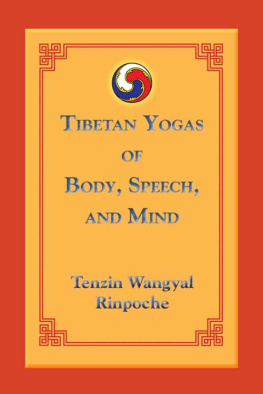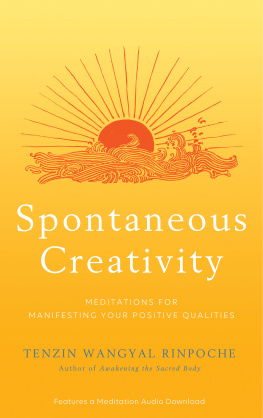
Bonus eBook Content
Thank you for purchasing the Awakening the Luminous Mind eBook
by Tenzin Wangyal Rinpoche. This eBook includes a free audio download!
To access this bonus content, please visit www.hayhouse.com/ebookdownloads
and enter the Product ID and Download Codes as they appear below.

For further assistance, please contact Hay House Customer Care by phone:
US (800) 654-5126 or INTL CC+(760) 431-7695 or visit www.hayhouse.com/contact.php .
Thank you again for your Hay House eBook purchase. Enjoy!
Hay House, Inc. P.O. Box 5100 Carlsbad, CA 92018-5100 (800) 654-5126 

Also by Tenzin Wangyal Rinpoche
Awakening the Sacred Body
Healing with Form, Energy, and Light
Tibetan Sound Healing
Tibetan Yogas of Body, Speech, and Mind
The Tibetan Yogas of Dream and Sleep
Unbounded Wholeness (with Anne Klein)
Wonders of the Natural Mind
Available from Hay House
Please visit:
Hay House USA: www.hayhouse.com
Hay House Australia: www.hayhouse.com.au
Hay House UK: www.hayhouse.co.uk
Hay House South Africa: www.hayhouse.co.za
Hay House India: www.hayhouse.co.in

Copyright 2012 by Tenzin Wangyal
Published and distributed in the United States by: Hay House, Inc.: www.hayhouse.com Published and distributed in Australia by: Hay House Australia Pty. Ltd.: www.hayhouse.com.au Published and distributed in the United Kingdom by: Hay House UK, Ltd.: www.hayhouse.co.uk Published and distributed in the Republic of South Africa by: Hay House SA (Pty), Ltd.: www.hayhouse.co.za Distributed in Canada by: Raincoast: www.raincoast.com Published in India by: Hay House Publishers India: www.hayhouse.co.in
Cover design: Tricia Breidenthal Interior design: Pamela Homan
All rights reserved. No part of this book may be reproduced by any mechanical, photographic, or electronic process, or in the form of a phonographic recording; nor may it be stored in a retrieval system, transmitted, or otherwise be copied for public or private useother than for fair use as brief quotations embodied in articles and reviewswithout prior written permission of the publisher.
The author of this book does not dispense medical advice or prescribe the use of any technique as a form of treatment for physical, emotional, or medical problems without the advice of a physician, either directly or indirectly. The intent of the author is only to offer information of a general nature to help you in your quest for emotional and spiritual well-being. In the event you use any of the information in this book for yourself, which is your constitutional right, the author and the publisher assume no responsibility for your actions.
Library of Congress Cataloging-in-Publication Data
Wangyal, Tenzin.
Awakening the luminous mind : Tibetan meditation for inner peace and joy / Tenzin Wangyal Rinpoche ; edited by Marcy Vaughn. 1st edition.
pages cm
ISBN 978-1-4019-3761-4 (pbk.)
1. MeditationBon (Tibetan religion) I. Vaughn, Marcy, editor. II. Title.
BQ7982.2.W326 2012
299.54dc23
2012010774
Tradepaper ISBN: 978-1-4019-3761-4
Digital ISBN: 978-1-4019-3762-1
15 14 13 12 4 3 2 1
1st edition, June 2012
Printed in the United States of America

C ONTENTS

Meditation is a method of recognizing and being aware of the inherent completeness of each moment. It is not a matter of cultivating or finding something you dont have, but of being aware of what you already have. The awareness of ones inherent completeness is pure, and this awareness pervades all that is experienced, and guides all of our actions. The methods in this book do not involve learning rituals or following complicated philosophies. Rather, you are pointed to experience life directly, without any religious or philosophical views, forms, or divisions.
Among the practices we will directly experience in the book are the meditation instructions of Dawa Gyaltsen, a Tibetan Bn dzogchen master who lived in the 8th century. Dawa Gyaltsen was the 24th dzogchen master of my lineage, called the Zhang Zhung Nyen Gy, or oral tradition of Zhang Zhung, in which spoken instructions were passed down from teacher to student over the centuries in the ancient land of Zhang Zhung, and then Tibet. The Tibetan name of his teachings, dzogchen , means great perfection or great completeness. At the core of dzogchen is the view that all sentient beings are primordially pure and perfected, with the potential to spontaneously manifest in a beneficial way. This traditional language may sound mysterious, but it simply means that from its very origin, our nature is perfectly pure and complete; and this purity, when it is unobstructed, can express itself effortlessly, in a way that benefits everyone. This capacity is within each and every one of us. It is our nature. When we fail to recognize this true nature, we suffer and can cause harm to others. When we do recognize our inherent nature, we are able to liberate our own suffering. As we mature in this recognition, we can be of great comfort and help to others.
Many of the dzogchen masters were not intellectuals or scholars. Some couldnt even read. But the transmission of the teachings from master to student, and the warmth and blessing of this connection, remain unbroken to this day. Traditionally, the teacher introduced the student to the nature of mind, which is already pure and complete. He or she pointed out or affirmed a recognition that the student was having. After receiving these pointing-out instructions, the students meditated in solitude for a period of time until their meditative realization became stable. Their realization would then be expressed in a few lines of spiritual advice directly from the heart. They imparted this heart advice, the fruit of their practice, to the next student, who in turn contemplated and practiced it until also attaining realization. Dawa Gyaltsens heart instructions consist of five lines, referred to as the Fivefold Teaching of Dawa Gyaltsen. These lines constitute a simple, elegant, and complete path to realization.
Vision is mind.
Mind is empty.
Emptiness is clear light.
Clear light is union.
Union is great bliss.
These five lines describe a path of pure awareness, leading us from confusion to great bliss. They are applicable in any situation and in any moment. As a young monk, I carried these five lines in my pocket when I left my birthplace, India, for the first time, having been called to teach the Tibetan Bn tradition to the West. I would often sit in an Italian caf and contemplate the lines as I observed life streaming around me. Now in the United States, they continue to guide me in my life as husband, father, and teacher.
Next page

















